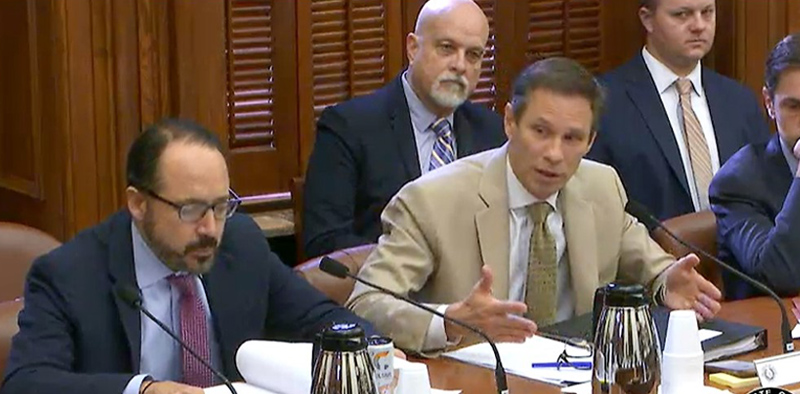
Texas lawmakers have advanced several bills that, while revised, still threaten to upend the ERCOT market and punish renewable energy.
Introduced last month, the bills would fund the construction of 10 GW of gas-fired plants that would only be used to prevent load shed; place limits on how much renewable generation can be built; institute a firming requirement for all resources and load-serving entities; and mandate that generation be built closer to load to reduce transmission costs. (See Texas Senate Lays out Changes to ERCOT Market.)
The Texas Senate approved four bills Wednesday, three of which cleared the Business and Commerce (B&C) Committee earlier in the week. They include Senate Bill 6, which has drawn widespread opposition over its proposed Texas Energy Insurance Program. Under the program, interest-free loans from state funds — Texas has a $32.7 billion budget surplus — would be used to build break-glass-in-case “reliability assets,” defined as gas plants in ERCOT’s footprint with on-site fuel storage.
 Sen. Charles Schwertner, author of SB 6 and SB 7, explains his legislation to the Texas Senate. | Texas Senate
Sen. Charles Schwertner, author of SB 6 and SB 7, explains his legislation to the Texas Senate. | Texas SenateThe bill’s detractors include Grover Norquist’s Americans for Tax Reform (ATR) conservative advocacy group. It said SB 6 and other legislation “all seek to impose arbitrary restrictions on energy producers or authorize superfluous subsidies.”
“While the motivation behind them is well-meaning, such misguided intervention is likely to produce barriers to entry that reduce competition and raise consumer prices,” the organization added.
SB 6 is similar to Berkshire Hathaway Energy’s proposal during the 2021 legislative session to fund $8.3 billion to build 10 GW of gas fired generation for “blackout insurance.” The proposal never made it into legislation. (See Stakeholder Soapbox: Berkshire’s Proposal Will Prevent Another Texas Power Catastrophe.)
The current legislation is expected to cost about $10 billion. However, the costs could be as high as $18 billion, according to a Lower Colorado River Authority document recently obtained through an open records request by Austin’s NPR radio station, KUT. In the document, LCRA says it could build about 5.6 GW of reliability assets for $10 billion in capital costs and about 10 GW for $18 billion.
State Sen. Nathan Johnson (D) reminded the B&C Committee Monday that stakeholders have raised concerns for several years over an off-market backup system that could have “damaging, perhaps destructive effects” to the ERCOT market.
 Sen. Nathan Johnson (right) questions the legislation. | Texas Senate
Sen. Nathan Johnson (right) questions the legislation. | Texas Senate“To the extent we’re going to preserve our competitive market, I’m concerned that the scope of this is too large and it ought to be brought down considerably in size and work in conjunction with other elements,” he said. “It seems to wag the whole system at this size.”
“This bill … speaks to the concerns of millions of Texans regarding what do we do when there is anticipated extreme heat or extreme cold. Do we have enough backup electricity to make sure our grid doesn’t go down?” B&C Chair Charles Schwertner (R) said during Monday’s committee meeting. “This is just like a generator at your house. It is an insurance electricity backup system that stands behind the energy-only market here in Texas.”
Schwertner, who drafted the bill, said he had added several revisions after further input from 20 “major stakeholders” and hours of discussion with members and stakeholders. The modifications include weakening the thresholds project developers must meet to establish “financial stability” by reducing the applicant’s ownership of existing capacity from 15 GW down to 2.5 GW and not requiring total assets of $10 billion for every GW of capacity applied for.
However, applicants will be required to have an investment grade credit rating.
The substitute bill’s biggest revision keeps the program’s plants from entering the competitive day-ahead and real-time markets for 40 years and clarifies that Texas regulators should continue to work on market design fixes that address the state’s reliability issues.
That could satisfy some market participants who have said the temptation would be too great not to use the plants sitting on the sidelines.
“The concern is that you’re going to be paying for these resources and they’re going to be sitting there,” South Texas Electric Cooperative General Manager Clif Lange said during a legislative hearing last week. “It’s going to be extremely tempting when we come back in two years or four years to want to make sure that the [Public Utility] Commission uses these a little bit more frequently. I think you’re going to get pressured to try to make sure that those are deployed at a lower price level.”
Lange said that should the gas units enter the ERCOT markets, they could start displacing competitive resources and lead to price distortions.
“You start to see more pressure on the existing portfolio of assets and as a result, you potentially start flushing out more dispatchable generation,” he said, warning that lower-cost renewable generation will continue to replace inefficient thermal resources.
Energy producer WattBridge has spent $2 billion in adding 4 GW of fast-start gas generators since 2018. In testimony before both legislative bodies, CEO Mike Alvarado said his company is one of those that would be affected.
“The market we invested in over the last 36 months is not the market that exists today,” he said. “We do not anticipate investing any further in ERCOT; the current market conditions simply do not allow it, and the current legislation considered by the Senate makes it that much more challenging for our business.”
Other provisions in the substitute bill would cap the sidelined gas plants’ regulated rate of return at 10%. Independent research firm Clearview Energy Partners said the revised legislation would also ensure that a generator with one or more participating plants does not receive more than $100 million a year in revenue per gigawatt of installed generation capacity.
Should the state not provide sufficient funding for the program, the bill directs the PUC to set a nonbypassable charge to all transmission and distribution utilities, municipally owned utilities and electric cooperatives in ERCOT.
The Senate, controlled 19-11 by Republicans, passed SB 6 by a 22-9 margin, with one Republican and four Democrats crossing the aisle. Johnson and the other two Democrats on the B&C Committee all voted “present” Monday in sending the bill to the floor.
Another ‘Legislative Priority’
Senators also unanimously approved SB 7 Wednesday. Along with SB 6, it has been designated a “legislative priority” by Lt. Gov. Dan Patrick, who controls the Senate.
The bill creates a new “firming” ancillary services program that directs load-serving entities to purchase “dispatchable” reliability reserve services on a day-ahead basis. Revisions to the bill mandate that resources offering the service be capable of running for at least 10 hours, up from four hours as originally drafted. That would essentially lock out energy storage, which ERCOT considers dispatchable.
Americans for Tax Reform said SB 7 would subsidize energy capacity instead of compensating firms for electricity they sell and would create an “adverse incentive structure wherein energy producers would become more reliant on taxpayer subsidies.”
“This would hamper the Texas energy industry and likely lead to increased prices on consumers as well as producers,” Americans for Tax Reform said.
In testimony before lawmakers last month, ERCOT CEO Pablo Vegas called the concept a “tax” and said it could lead to increased generation retirements.
“We would lose energy resources in the short term,” he said. “Resources that cannot be economic under the new cost burden that’s put in place [by SB 7] would pull out of the market, so we would have an energy deficit from that.”
The Senate has already sent several other bills to the House of Representatives. They include:
- SB 2012, which would establish policy guardrails should the PUC implement the performance credit mechanism. Lawmakers have thrown cold water on the construct, advising the regulators that they can’t go forward with it without legislative input.
- SB 2014, which would make renewable energy credits voluntary instead of mandatory.
- SB 2015, which would mandate that 50% of generating capacity installed in ERCOT after this year be sourced from dispatchable resources.
- SB 1287, which would require developers to pay for some of the interconnection transmission costs, adding more hurdles for renewable resources that are built far from the grid.
Renewable generation already accounts for a bit more than half of ERCOT’s capacity and for most of the projects in ERCOT’s interconnection queue. According to a study by Joshua Rhodes, a University of Texas researcher, wind and solar resources saved Texas consumers $11 billion in just 2022.
“I worry that some of the bills come across as anti-renewable,” Sen. Judith Zaffirini (D) said Monday. “And so, we want to make sure that we have the dispatchable energy that we have but not necessarily hurt, not punish, renewables.”


